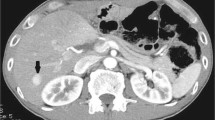Abstract
This report presents the case of a unique hepatocellular nodule occurring in a 73-year-old Japanese male with diabetes mellitus and mild obesity. The nodule consisted of hepatocyte-like tumor cells and abundant foam cell type histiocytes that filled up a sinusoid-like space and formed central loose fibrosis. The superficial area did not contain as many histiocytes and showed hepatocellular adenoma character, but there was a focal hepatocellular carcinoma-like lesion, thus suggesting hepatocellular adenoma with malignant transformation. The background liver showed an almost normal histology except for mild steatosis with no specific infiltration of macrophages. These macrophages contained abundant fat droplets, whereas the tumor cells had no fat droplets. The expressions of monocyte chemoattractant protein-1 and macrophage colony-stimulating factor were significantly higher in the tumor than in the background liver. These findings suggested such macrophage infiltration induced by the tumor cells and these macrophages probably phagocytosed surplus fat at the intercellular space of this unique tumor.



Similar content being viewed by others
References
Ishak KG, Ishak KG, Goodman ZD, Goodman ZD, Stocker JT, Stocker JT. Atlas of tumor pathology: tumors of the liver and intrahepatic bile ducts. Washington, DC: Armed Forces Institute of Pathology; 2001. p. 9–21.
Kojiro M. Pathology of hepatocellular carcinoma. Massachusetts: Blackwell; 2006.
Goodman ZD. Neoplasms of the liver. Mod Pathol. 2007;20(Suppl 1):S49–60.
Cavaillon JM. Cytokines and macrophages. Biomed Pharmacother. 1994;48:445–53.
Kai K, Kitajima Y, Hiraki M, Satoh S, Tanaka M, Nakafusa Y, et al. Quantitative double-fluorescence immunohistochemistry (qDFIHC), a novel technology to assess protein expression: a pilot study analyzing 5-FU sensitive markers thymidylate synthase, dihydropyrimidine dehydrogenase and orotate phosphoribosyl transferases in gastric cancer tissue specimens. Cancer Lett. 2007;258:45–54.
Ito M, Sasaki M, Wen CY, Nakashima M, Ueki T, Ishibashi H, et al. Liver cell adenoma with malignant transformation: a case report. World J Gastroenterol. 2009;9:2379–81.
Micchelli ST, Vivekanandan P, Boitnott JK, Pawlik TM, Choti MA, Torbenson M. Malignant transformation of hepatic adenomas. Mod Pathol. 2008;21:491–7.
Farrell GC, Joshua DE, Uren RF, Baird PJ, Perkins KW, Kronenberg H. Androgen-induced hepatoma. Lancet. 1975;22:430–2.
Ferrell LD. Hepatocellular carcinoma arising in a focus of multilobular adenoma. A case report. Am J Surg Pathol. 1993;17:525–9.
Foster JH, Berman MM. The malignant transformation of liver cell adenomas. Arch Surg. 1994;129:712–7.
Paradis V, Zalinski S, Chelbi E, Guedj N, Degos F, Vilgrain V, et al. Hepatocellular carcinomas in patients with metabolic syndrome often develop without significant liver fibrosis: a pathological analysis. Hepatology. 2009;49:851–9.
Paradis V, Champault A, Ronot M, Deschamps L, Valla DC, Vidaud D, et al. Telangiectatic adenoma: an entity associated with increased body mass index and inflammation. Hepatology. 2007;46:140–6.
Acknowledgments
We would like to thank Dr. H. Yano, Dr. O. Nakashima and Dr. M. Kojiro of the Department of Pathology, Kurume University, Japan, for their kind comments and advice concerning the pathological diagnosis and immunohistochemistry of PIVKA-II. We also thank Mr. F. Mutoh and Mr. S. Nakahara for their contributions to the immunohistochemical and ultrastructural studies.
Author information
Authors and Affiliations
Corresponding author
Rights and permissions
About this article
Cite this article
Kai, K., Miyoshi, A., Tokunaga, O. et al. A hepatocellular neoplasm accompanied with massive histiocyte infiltration. Clin J Gastroenterol 3, 40–44 (2010). https://doi.org/10.1007/s12328-009-0123-7
Received:
Accepted:
Published:
Issue Date:
DOI: https://doi.org/10.1007/s12328-009-0123-7




